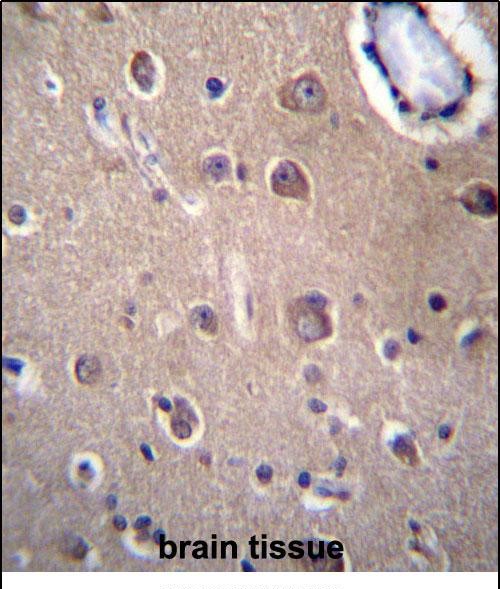SLC8A3 Antibody (C-term)
Affinity Purified Rabbit Polyclonal Antibody (Pab)
- 产品详情
- 文献引用 : 1
- 实验流程
- 背景知识
Application
| WB, IHC-P, E |
|---|---|
| Primary Accession | P57103 |
| Other Accession | NP_892114.1 |
| Reactivity | Human |
| Host | Rabbit |
| Clonality | Polyclonal |
| Isotype | Rabbit IgG |
| Calculated MW | 103010 Da |
| Antigen Region | 585-614 aa |
| Gene ID | 6547 |
|---|---|
| Other Names | Sodium/calcium exchanger 3, Na(+)/Ca(2+)-exchange protein 3, Solute carrier family 8 member 3, SLC8A3, NCX3 |
| Target/Specificity | This SLC8A3 antibody is generated from rabbits immunized with a KLH conjugated synthetic peptide between 585-614 amino acids of human SLC8A3. |
| Dilution | WB~~1:1000 IHC-P~~1:100~500 E~~Use at an assay dependent concentration. |
| Format | Purified polyclonal antibody supplied in PBS with 0.09% (W/V) sodium azide. This antibody is purified through a protein A column, followed by peptide affinity purification. |
| Storage | Maintain refrigerated at 2-8°C for up to 2 weeks. For long term storage store at -20°C in small aliquots to prevent freeze-thaw cycles. |
| Precautions | SLC8A3 Antibody (C-term) is for research use only and not for use in diagnostic or therapeutic procedures. |
| Name | SLC8A3 |
|---|---|
| Synonyms | NCX3 |
| Function | Mediates the electrogenic exchange of Ca(2+) against Na(+) ions across the cell membrane, and thereby contributes to the regulation of cytoplasmic Ca(2+) levels and Ca(2+)-dependent cellular processes. Contributes to cellular Ca(2+) homeostasis in excitable cells, both in muscle and in brain. In a first phase, voltage-gated channels mediate the rapid increase of cytoplasmic Ca(2+) levels due to release of Ca(2+) stores from the endoplasmic reticulum. SLC8A3 mediates the export of Ca(2+) from the cell during the next phase, so that cytoplasmic Ca(2+) levels rapidly return to baseline. Contributes to Ca(2+) transport during excitation-contraction coupling in muscle. In neurons, contributes to the rapid decrease of cytoplasmic Ca(2+) levels back to baseline after neuronal activation, and thereby contributes to modulate synaptic plasticity, learning and memory (By similarity). Required for normal oligodendrocyte differentiation and for normal myelination (PubMed:21959935). Mediates Ca(2+) efflux from mitochondria and contributes to mitochondrial Ca(2+) ion homeostasis (By similarity). |
| Cellular Location | Cell membrane; Multi-pass membrane protein. Perikaryon {ECO:0000250|UniProtKB:P70549}. Cell projection, dendrite {ECO:0000250|UniProtKB:P70549}. Cell projection, dendritic spine {ECO:0000250|UniProtKB:P70549}. Cell membrane, sarcolemma {ECO:0000250|UniProtKB:S4R2P9}. Cytoplasm, sarcoplasm {ECO:0000250|UniProtKB:S4R2P9}. Cell junction {ECO:0000250|UniProtKB:S4R2P9}. Mitochondrion outer membrane {ECO:0000250|UniProtKB:S4R2P9}; Multi-pass membrane protein {ECO:0000250|UniProtKB:S4R2P9}. Cytoplasm, perinuclear region. Endoplasmic reticulum membrane; Multi-pass membrane protein {ECO:0000250|UniProtKB:S4R2P9}. Note=Detected at neuromuscular junctions. {ECO:0000250|UniProtKB:S4R2P9} |
| Tissue Location | Isoform 2 is expressed in brain and skeletal muscle. Isoform 3 is expressed in excitable cells of brain, retina and skeletal muscle. Isoform 4 is expressed in skeletal muscle |
For Research Use Only. Not For Use In Diagnostic Procedures.

Provided below are standard protocols that you may find useful for product applications.
BACKGROUND
This gene encodes a member of the sodium/calcium exchanger integral membrane protein family. Three mammalian isoforms in family 8 have been identified. Na+/Ca2+ exchange proteins are involved in maintaining Ca2+ homeostasis in a wide variety of cell types. The protein is regulated by intracellular calcium ions and is found in both the plasma membrane and intracellular organellar membranes, where exchange of Na+ for Ca2+ occurs in an electrogenic manner. Alternative splicing has been observed for this gene and multiple variants have been described.
REFERENCES
Rose, J.E., et al. Mol. Med. 16 (7-8), 247-253 (2010) :
Pulina, M.V., et al. J. Biol. Chem. 281(28):19645-19654(2006)
Gomez-Villafuertes, R., et al. J. Neurosci. 25(47):10822-10830(2005)
Lindgren, R.M., et al. Gene 348, 143-155 (2005) :
Gabellini, N. Mol. Neurobiol. 30(1):91-116(2004)
终于等到您。ABCEPTA(百远生物)抗体产品。
点击下方“我要评价 ”按钮提交您的反馈信息,您的反馈和评价是我们最宝贵的财富之一,
我们将在1-3个工作日内处理您的反馈信息。
如有疑问,联系:0512-88856768 tech-china@abcepta.com.






















 癌症的基本特征包括细胞增殖、血管生成、迁移、凋亡逃避机制和细胞永生等。找到癌症发生过程中这些通路的关键标记物和对应的抗体用于检测至关重要。
癌症的基本特征包括细胞增殖、血管生成、迁移、凋亡逃避机制和细胞永生等。找到癌症发生过程中这些通路的关键标记物和对应的抗体用于检测至关重要。 为您推荐一个泛素化位点预测神器——泛素化分析工具,可以为您的蛋白的泛素化位点作出预测和评分。
为您推荐一个泛素化位点预测神器——泛素化分析工具,可以为您的蛋白的泛素化位点作出预测和评分。 细胞自噬受体图形绘图工具为你的蛋白的细胞受体结合位点作出预测和评分,识别结合到自噬通路中的蛋白是非常重要的,便于让我们理解自噬在正常生理、病理过程中的作用,如发育、细胞分化、神经退化性疾病、压力条件下、感染和癌症。
细胞自噬受体图形绘图工具为你的蛋白的细胞受体结合位点作出预测和评分,识别结合到自噬通路中的蛋白是非常重要的,便于让我们理解自噬在正常生理、病理过程中的作用,如发育、细胞分化、神经退化性疾病、压力条件下、感染和癌症。







